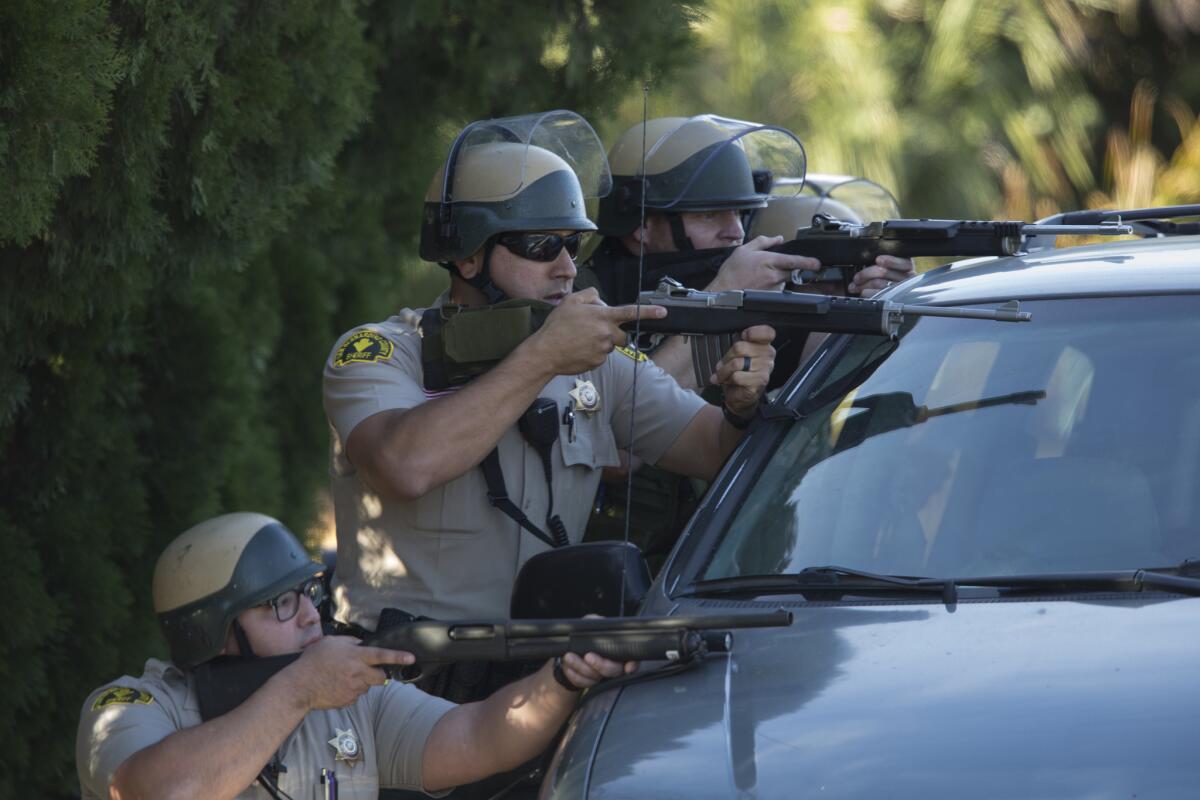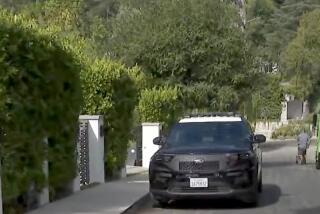Local authorities are the first line of defense on âlone wolfâ terrorism

San Bernardino County sheriffâs deputies draw guns behind a minivan on Richardson St. during a search for suspects involved in the mass shooting of 14 people at the Inland Regional Center in San Bernardino.
In 2005, Torrance police officers searched the apartment of two men suspected of robbing a gas station.
There, the officers found a lengthy manifesto and a list of potential targets, including synagogues and military sites. They had stumbled on an Islamist terrorist cell in the advanced stages of an attack plan.
The San Bernardino massacre, which killed 14 people, has focused new attention on âlone wolfâ terrorists who plan attacks away from traditional high-profile targets without directly coordinating with others.
While the FBI typically takes the lead in major terrorism investigations, local police officers and sheriffâs deputies are the initial line of defense â especially in the case of home-grown plotters.
With their local intelligence and connections to the communities they serve, police are often the first to pick up on clues that something is wrong â or to fortuitously come across a dangerous situation. Large agencies like the Los Angeles Police Department and Los Angeles County Sheriffâs Department have sizable counter-terrorism units that comb the Internet for suspicious postings, follow up on tips and cultivate contacts in the community.
Neighbors or friends might notice strange behavior, an uptick in bulky package deliveries or changes to a personâs routine. Human intelligence is the key, and local authorities are more likely than their federal counterparts to be plugged into those sources, said Deputy Chief Michael Downing, who oversees the LAPDâs counter-terrorism bureau.
But the challenges are daunting. Sometimes, as with the San Bernardino assailants Syed Rizwan Farook and Tashfeen Malik, even family members said they did not notice any warning signs. Federal authorities say Malik wrote a Facebook post pledging her allegiance to an Islamic State group, but there is no evidence so far that they were connected to a larger terror cell.
âSelf-radicalization poses a tremendous problem, as it is hardest to detect,â Downing said. âFor us, it has always been easier to detect a network group adversary, because someone is going to slip up or hit a trip wire, versus a lone wolf.â
At the LAPD, the Counter-Terrorism and Special Operations Bureauâs 900 officers include some Muslims and several who speak who speak Arabic or Urdu. The bureau maintains relationships with local mosques and works closely with other law enforcement agencies, including the FBI.
The LAPDâs version of the âIf you see something, say somethingâ program, which encourages residents to report suspected terrorist activity, has won praise but also raised concerns in recent years.
In 2007, the LAPD scrapped a plan to map the cityâs Muslim population amid an outcry from Muslim groups and civil libertarians.
But law enforcement officials say it is precisely those kinds of grass-roots leads that could stop the next terror plot. Officers are constantly checking out reports of suspicious activity, searching for the smallest of clues, Downing said.
Chief Scott Edson, who oversees counter-terrorism at the L.A. County Sheriffâs Department, said residents should not hesitate to report anything out of the ordinary.
âNo oneâs going to say youâre profiling if you report suspicious activity,â Edson said. âI think we just have to understand that in todayâs climate, thereâs nothing you canât say. Give law enforcement an opportunity to listen to what you have to say, and let us legally determine whether there is something there or not.â
In addition to checking out tips, Edsonâs investigators monitor the Internet, looking for key words indicating an interest in extremism or terrorism. A declaration of allegiance to ISIS, like the one that allegedly surfaced on Malikâs Facebook, could come to their attention, but it would take more than a single post to raise serious suspicions, Edson said.
Separating those who intend to commit violence from those who are merely talking is part of the challenge.
âA lot of it is very innocent, but you share some information and other people have similar information, and thatâs when it starts turning into more of a clue,â Edson said.
Computer databases are a key aspect of information sharing with other agencies. For example, Edson said, if the same person receives parking tickets while taking photos of several different oil refineries, the citations are automatically cross-referenced.
Brian Levin, director of the Center for the Study of Hate and Extremism at Cal State San Bernardino, said terror networks have become more sophisticated at delivering their messages through social networks, making it easier to lure followers.
The San Bernardino massacre illustrates the difficulties of stopping terrorists who may have been radicalized mainly behind closed doors while surfing the Internet, said Orange County Sheriff Sandra Hutchens, who previously oversaw the counter-terrorism unit in L.A. County.
âSleepy little Orange County is pretty activeâ in producing terrorists, Hutchens said. She noted that several aspiring foreign fighters arrested and charged by federal authorities in recent years came from the county and were heading to Syria to join ISIS.
In the U.S., homegrown terrorists come from a range of socioeconomic and educational backgrounds, making it hard to generate a criminal profile, said Brian Michael Jenkins, a terrorism expert at the Rand Corp., a Santa Monica think tank.
It is someone like Farook, seemingly leading a normal life, who poses the biggest challenge for law enforcement and who stokes the biggest fear in the public.
âThe fact that this was such an ordinary guy, who was likable, who got along with other people at work ⌠It was a Christmas party. It was the Inland Regional Center, which is not at the top of anybodyâs perceived target list,â Jenkins said. âThat underscores the point that this could happen anywhere. This person Iâve known for years is maybe, as we speak, planning to kill me.â
[email protected] | @cindychangLA
MORE ON SAN BERNARDINO SHOOTING
San Bernardino residents are weary and on edge after a traumatic week
Mystery behind rampage takes ominous tone as probe shifts to âtypical housewifeâ
Exclusive: Tashfeen Malik was a âmodern girlâ who began posting extremist messages on Facebook
More to Read
Sign up for Essential California
The most important California stories and recommendations in your inbox every morning.
You may occasionally receive promotional content from the Los Angeles Times.












